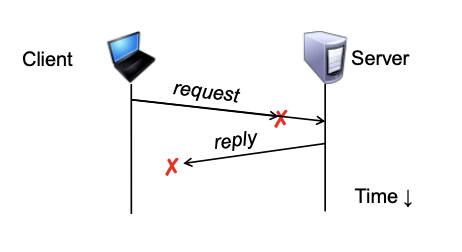August 19, 2022
Distributed Systems System Design Interview
Failures, from client’s perspective

The cause of the failure is hidden from the client!
At-Least-Once scheme
- Simplest scheme for handling failures
- Client stub waits for a response, for a while
- Response is an acknowledgement message from the server stub
- If no response arrives after a fixed timeout time period, then client stub re-sends the request
- Repeat the above a few times
- Still no response? Return an error to the application
At-Least-Once and side effects
- Client sends a “debit $10 from bank account” RPC

At-Least-Once and writes
- Consider a client storing key-value pairs in a database
- put(x, value), then get(x): expect answer to be value


So is At-Least-Once ever okay?
- Yes: If they are read-only operations with no side effects
- e.g., read a key’s value in a database
- Yes: If the application has its own functionality to cope with duplication and reordering
At-Most-Once scheme
Idea: server RPC stub detects duplicate requests
- Returns previous reply instead of re-running handler
- How to detect a duplicate request?
- Test: Server stub sees same function, same arguments twice
- No! Sometimes applications legitimately submit the same function with same augments, twice in a row
- Test: Server stub sees same function, same arguments twice
- How to detect a duplicate request?
- Client stub includes unique transaction ID (xid) with each RPC request
- Client stub uses same xid for retransmitted requests
At-Most-Once Server Stub
if seen(xid):
retval = old(xid)
else:
retval = handler()
old(xid) = retval
seen(xid) = true
return retvalAt-Most-Once: Providing unique XIDs
- Combine a unique client ID (e.g., IP address) with the current time of day
- Combine unique client ID with a sequence number
- Suppose client crashes and restarts. Can it reuse the same client ID?
- Big random number (probabilistic, not certain guarantee)
At-Most-Once: Discarding server state
- Problem: seen and old arrays will grow without bound
- Observation: By construction, when the client gets a response to a particular xid, it will never re-send it
- Client could tell server “I’m done with xid x – delete it”
- Have to tell the server about each and every retired xid
- Could piggyback on subsequent requests
- Have to tell the server about each and every retired xid
Significant overhead if many RPCs are in flight, in parallel
- Suppose xid = ⟨unique client id, sequence no.⟩
- e.g., ⟨42, 1000⟩, ⟨42, 1001⟩, ⟨42, 1002⟩
- Client includes “seen all replies ≤ X” with every RPC
- Much like TCP sequence numbers, acks
- How does client know the server received the info about retired RPCs?
- Each one of these is cumulative: later seen messages subsume earlier ones
At-Most-Once: Concurrent requests
- Problem: How to handle a duplicate request while the original is still executing?
- Server doesn’t know reply yet. And we don’t want to run procedure twice
- Idea: Add a pending flag per executing RPC
- Server waits for the procedure to finish, or ignores
At-Most-Once: Server crash and restart
- Problem: Server may crash and restart
- Does server need to write its tables to disk?
- Yes! On server crash and restart:
- If old, seen tables are only in memory:
- Server will forget, accept duplicate requests
- If old, seen tables are only in memory:
Exactly-once?
- Need retransmission of at least once scheme
- Plus the duplicate filtering of at most once scheme
- To survive client crashes, client needs to record pending RPCs on disk
- So it can replay them with the same unique identifier
- To survive client crashes, client needs to record pending RPCs on disk
- Plus story for making server reliable
- Even if server fails, it needs to continue with full state
- To survive server crashes, server should log to disk results of completed RPCs (to suppress duplicates)
Exactly-once for external actions?
- Imagine that remote operation triggers an external physical thing
- e.g., dispense $100 from an ATM
- ATM could crash immediately before or after dispensing
- ATM would lose its state, and
- Don’t know which one happened (although can make window very small)
- Can’t achieve exactly-once in general, in presence of external actions
Summary
- Layers are our friends!
- RPCs are everywhere
- Help support machine heterogeneity
- Subtle issues around failures
- At-least-once w/ retransmission
- At-most-once w/ duplicate filtering
- Discard server state w/ cumulative acks
- Exactly-once with:
- at-least-once + at-most-once + fault tolerance + no external actions

